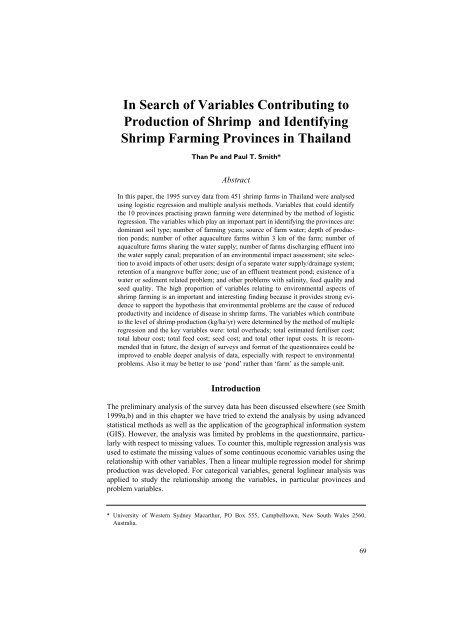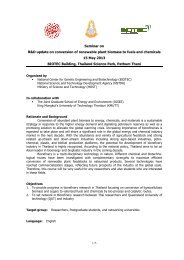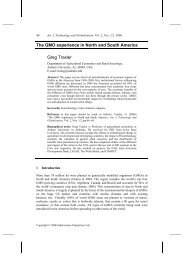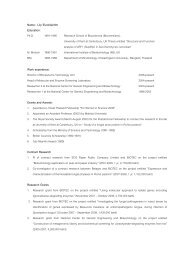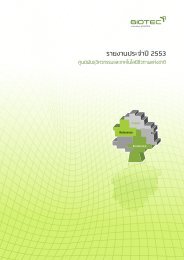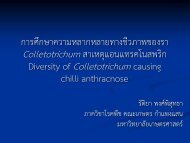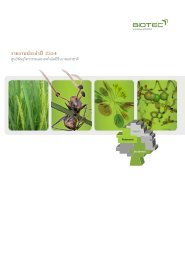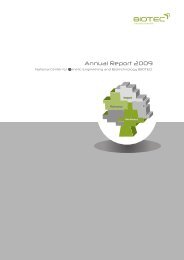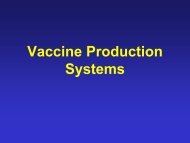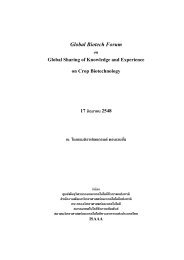Sirisup, S. 1988 Socio–economic changes <strong>in</strong> the course of commercialisation. <strong>Coastal</strong> aquaculture<strong>in</strong> Chantaburi Prov<strong>in</strong>ce, <strong>Thailand</strong>. Masters thesis. Bangkok, Asian Institute of Technology.Smith, P. 1993. Prawn farm<strong>in</strong>g <strong>in</strong> Australia—sediment is a major issue. Australian Fisheries,December 1993, 29–32.Smith, P.T. 1995. Characterisation of the effluent from prawn ponds on the Clarence River,Australia. In: Proceed<strong>in</strong>gs of Susta<strong>in</strong>able <strong>Aquaculture</strong> 95, PACON (Pacific Congress onMar<strong>in</strong>e Science and Technology) International, 327–338.Smith, P.T. 1996a. Physical and chemical characteristics of sediments from prawn farms andmangrove habitats on the Clarence River, Australia. <strong>Aquaculture</strong>, 146, 47–83.Smith, P.T. 1996b. Toxic effects of blooms of mar<strong>in</strong>e species of Oscillatoriales on farmedprawns (Penaeus monodon, Penaeus japonicus) and br<strong>in</strong>e shrimp (Artemia sal<strong>in</strong>a). Toxicon,34, 857–869.Smith, P.T. 1998. Effects of remov<strong>in</strong>g accumulated sediments on the bacteriology of pondsused to culture Penaeus monodon. Asian Fisheries Science, 10, 355–370.Snedaker, S.C. and Getter, C.D. 1985. <strong>Coastal</strong> resources management guidel<strong>in</strong>es. Renewableresources <strong>in</strong><strong>for</strong>mation service. <strong>Coastal</strong> Management Publication No. 2. Colombia,<strong>Research</strong> Plann<strong>in</strong>g Institute.Suraswadi, P. 1990. State of the <strong>Thailand</strong> shrimp <strong>in</strong>dustry. International Seafood Conference,Budapest, Hungary, 29 October 1990, 8p.Tanasomwang, V. 1994. Mar<strong>in</strong>e shrimp culture <strong>in</strong> central <strong>Thailand</strong>. In: Proceed<strong>in</strong>gs of theSoutheast Asian Aquatic Animal Disease Control Programme (SEAADCP) Prawn HealthManagement Workshop, 10–20 January 1994, 106p.Therivel, R., Wilson, E., Thompson, S., Heaney, D. and Pritchard, D. 1992. Strategic EnvironmentalAssessment. London, Earthscan Publications.Tiensongrusmee, B. 1970. A present status of shrimp farm<strong>in</strong>g <strong>in</strong> <strong>Thailand</strong>. Invertebrate FisheriesInvestigations, Mar<strong>in</strong>e Fisheries Laboratory, Division of <strong>Research</strong> and Investigations,Department of Fisheries, Bangkok, <strong>Thailand</strong>. Contribution No. 18, 34p.Tookw<strong>in</strong>as, S. 1993. Intensive mar<strong>in</strong>e shrimp farm<strong>in</strong>g techniques <strong>in</strong> <strong>Thailand</strong>. In: Proceed<strong>in</strong>gsof the First International Symposium on <strong>Aquaculture</strong> Technology and Investment Opportunities,Riyadh, Saudi Arabia, 11–14 April 1993. M<strong>in</strong>istry of Agriculture and Water, K<strong>in</strong>gAbdulaziz City <strong>for</strong> Science and Technology and Riyadh Chamber and Industry, 230–240.Tookw<strong>in</strong>as, S. and Leeruksakiat, P. 1994. Application of GIS technique <strong>for</strong> shrimp farm and mangrove<strong>for</strong>est development <strong>in</strong> Chantaburi Prov<strong>in</strong>ce, <strong>Thailand</strong>. Paper of Kung Krabean Bay RoyalDevelopment Centre, Klongkud Subdistrict, Thamai District, Chantaburi, <strong>Thailand</strong>, 25p.Tookw<strong>in</strong>as, S., Malem, F. and Songsangj<strong>in</strong>da, P. 1993. Quality and quantity of water from<strong>in</strong>tensive mar<strong>in</strong>e shrimp farms at Kung Krabean Bay, Chantaburi Prov<strong>in</strong>ce, Eastern <strong>Thailand</strong>.Kung Krabean Royal Development Study Centre (unpublished), 20p.Turnbull, J.F. 1993. Preface to Dr D. Baird’s report—Short-term statistical consultancy on thel<strong>in</strong>kage between disease and water quality <strong>in</strong> farmed shrimp ponds. A report to the OverseasDevelopment Agency’s North East Sumateran Prawn Project. Stirl<strong>in</strong>g, Scotland, Instituteof <strong>Aquaculture</strong>, Stirl<strong>in</strong>g University, i–iv.Turnbull, J., Chanratchakool, P. and MacRae, I.H. 1994. Proceed<strong>in</strong>gs of the SEAFDEC SoutheastAsian Aquatic Animal Disease Control Programme (SEAADCP) Prawn Health ManagementWorkshop, 10–20 January 1994, 106p.Wickens, J.F. 1985. Ammonia production and oxidation dur<strong>in</strong>g the culture of mar<strong>in</strong>e prawnsand lobsters <strong>in</strong> laboratory recirculation systems. Aquacultural Eng<strong>in</strong>eer<strong>in</strong>g, 4, 155–174.World Commission on Environmental Development 1987. The world: our common future.Ox<strong>for</strong>d, Ox<strong>for</strong>d University Press, 400p.%'
!In Search of Variables Contribut<strong>in</strong>g toProduction of <strong>Shrimp</strong> and Identify<strong>in</strong>g<strong>Shrimp</strong> Farm<strong>in</strong>g Prov<strong>in</strong>ces <strong>in</strong> <strong>Thailand</strong>Than Pe and Paul T. Smith*AbstractIn this paper, the 1995 survey data from 451 shrimp farms <strong>in</strong> <strong>Thailand</strong> were analysedus<strong>in</strong>g logistic regression and multiple analysis methods. Variables that could identifythe 10 prov<strong>in</strong>ces practis<strong>in</strong>g prawn farm<strong>in</strong>g were determ<strong>in</strong>ed by the method of logisticregression. The variables which play an important part <strong>in</strong> identify<strong>in</strong>g the prov<strong>in</strong>ces are:dom<strong>in</strong>ant soil type; number of farm<strong>in</strong>g years; source of farm water; depth of productionponds; number of other aquaculture farms with<strong>in</strong> 3 km of the farm; number ofaquaculture farms shar<strong>in</strong>g the water supply; number of farms discharg<strong>in</strong>g effluent <strong>in</strong>tothe water supply canal; preparation of an environmental impact assessment; site selectionto avoid impacts of other users; design of a separate water supply/dra<strong>in</strong>age system;retention of a mangrove buffer zone; use of an effluent treatment pond; existence of awater or sediment related problem; and other problems with sal<strong>in</strong>ity, feed quality andseed quality. The high proportion of variables relat<strong>in</strong>g to environmental aspects ofshrimp farm<strong>in</strong>g is an important and <strong>in</strong>terest<strong>in</strong>g f<strong>in</strong>d<strong>in</strong>g because it provides strong evidenceto support the hypothesis that environmental problems are the cause of reducedproductivity and <strong>in</strong>cidence of disease <strong>in</strong> shrimp farms. The variables which contributeto the level of shrimp production (kg/ha/yr) were determ<strong>in</strong>ed by the method of multipleregression and the key variables were: total overheads; total estimated fertiliser cost;total labour cost; total feed cost; seed cost; and total other <strong>in</strong>put costs. It is recommendedthat <strong>in</strong> future, the design of surveys and <strong>for</strong>mat of the questionnaires could beimproved to enable deeper analysis of data, especially with respect to environmentalproblems. Also it may be better to use ‘pond’ rather than ‘farm’ as the sample unit.IntroductionThe prelim<strong>in</strong>ary analysis of the survey data has been discussed elsewhere (see Smith1999a,b) and <strong>in</strong> this chapter we have tried to extend the analysis by us<strong>in</strong>g advancedstatistical methods as well as the application of the geographical <strong>in</strong><strong>for</strong>mation system(GIS). However, the analysis was limited by problems <strong>in</strong> the questionnaire, particularlywith respect to miss<strong>in</strong>g values. To counter this, multiple regression analysis wasused to estimate the miss<strong>in</strong>g values of some cont<strong>in</strong>uous economic variables us<strong>in</strong>g therelationship with other variables. Then a l<strong>in</strong>ear multiple regression model <strong>for</strong> shrimpproduction was developed. For categorical variables, general logl<strong>in</strong>ear analysis wasapplied to study the relationship among the variables, <strong>in</strong> particular prov<strong>in</strong>ces andproblem variables.* University of Western Sydney Macarthur, PO Box 555, Campbelltown, New South Wales 2560,Australia.%(
- Page 8 and 9:
!The 1994 Workshop had a working hy
- Page 11 and 12:
!The Workshop at Hat Yai, SongkhlaA
- Page 13 and 14:
!ReferenceSmith, P.T., ed.. 1999. T
- Page 15 and 16:
!Shrimp Farming in ThailandOver the
- Page 18 and 19: ! !Table 1. World production (# 1,0
- Page 20 and 21: !Domestic and world demandJapan is
- Page 22 and 23: !Intensification of farms has been
- Page 24 and 25: !no significant difference between
- Page 26 and 27: !Production Practices and Technique
- Page 28 and 29: !use water which is almost fresh (F
- Page 30 and 31: !mended quantities for application
- Page 32 and 33: !the biological processes in sedime
- Page 34 and 35: !factors (Fegan 1994). Environmenta
- Page 36 and 37: !Acid sulphate soils occur in most
- Page 38 and 39: during the rainy season, some deter
- Page 40 and 41: Land subsidenceCoastal land subside
- Page 42 and 43: first when an area becomes environm
- Page 44 and 45: !Administration. Their work has inv
- Page 46 and 47: agriculture, selects coastal land p
- Page 48 and 49: Sustainability, Sustainable Develop
- Page 50 and 51: cultural and environmental asset va
- Page 52 and 53: $+Table 12. (cont’d) Impediments
- Page 54 and 55: $#Table 12. (cont’d) Impediments
- Page 56 and 57: $%Table 12. (cont’d) Impediments
- Page 58 and 59: capacities of alternative organisms
- Page 60 and 61: sources. This is one of the greates
- Page 62 and 63: Table 13. (cont’d) Summary of the
- Page 64 and 65: Boonyapiwat, S. 1989. Species of ph
- Page 66 and 67: Katesombun, B. 1992. Aquaculture pr
- Page 70 and 71: !In the preliminary analysis, the s
- Page 72 and 73: !until all variables had been teste
- Page 74 and 75: !quality problem over the past 3 ye
- Page 76 and 77: !Figure 1. Characterisation of prov
- Page 78 and 79: !Variables Contributing to Shrimp P
- Page 80 and 81: !Figure 5. Relationship between ave
- Page 82 and 83: !southern). The linear regression m
- Page 84 and 85: !Appendix. Results of logistic regr
- Page 86 and 87: !2) Trat ProvinceClassification tab
- Page 88 and 89: !Chi-square df significanceModel Ch
- Page 90 and 91: !8) Satun ProvinceClassification ta
- Page 92 and 93: !Variables in the equationConstant
- Page 94 and 95: !A total of 49 participants were in
- Page 96 and 97: ! ! ! ! ! ! ! ! ! ! ! ! ! ! ! ! !Fi
- Page 98 and 99: !All issues are listed in Appendice
- Page 100 and 101: !!were short term and one issue was
- Page 102 and 103: !reared broodstock (issue 71). They
- Page 104 and 105: !!Two participants commented that i
- Page 106 and 107: mation transfer and training. This
- Page 108 and 109: 108Appendix 1. (cont’d) Descripti
- Page 110 and 111: 110Appendix 1. (cont’d) Descripti
- Page 112 and 113: 112Appendix 2. Descriptive statisti
- Page 114 and 115: 114Appendix 2. (cont’d) Descripti
- Page 116 and 117: 116Appendix 3. Descriptive statisti
- Page 118 and 119:
118Appendix 4. Descriptive statisti
- Page 120 and 121:
120Appendix 5. Descriptive statisti
- Page 122 and 123:
Appendix 5. (cont’d) Descriptive
- Page 124 and 125:
Appendix 7. Descriptive statistics
- Page 126 and 127:
Appendix 7. (cont’d) Descriptive
- Page 128 and 129:
128Appendix 8. (cont’d) Descripti
- Page 130 and 131:
!ParticipantsAustraliaDr Paul T. Sm


